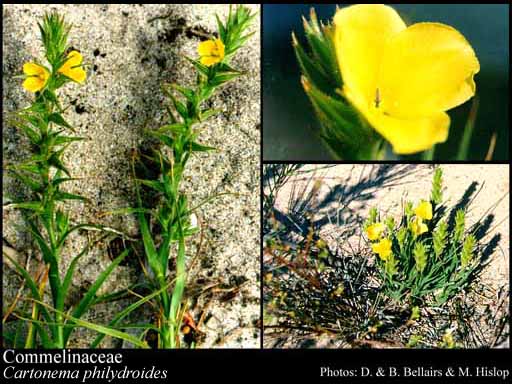- Reference
- Hist.Nat.Pl. 8:177 (1804)
- Name Status
- Current







Scientific Description
Common name. Spiderwort Family.
Habit and leaf form. Herbs, or herbaceous climbers; evergreen. Plants succulent and non-succulent. Annual, or perennial; plants with a basal concentration of leaves, or with neither basal nor terminal concentrations of leaves. Young stems cylindrical, or oval in section; often breaking easily at the nodes. Self supporting, or epiphytic, or climbing; stem twiners, or root climbers. Mesophytic, or helophytic. Leaves alternate; spiral, or distichous; more or less fleshy (often), or ‘herbaceous’; petiolate, or sessile; sheathing. Leaf sheaths with joined margins. Leaves simple. Leaf blades entire; parallel-veined. Leaves eligulate. Leaf blade margins entire. Vernation involute, or plicate (rarely). Vegetative anatomy. Plants with silica bodies, or without silica bodies. Leaf anatomy. Leaf blade epidermis without differentiation into ‘long’ and ‘short’ cells. Guard-cells not ‘grass type’. Stem anatomy. Secondary thickening absent.
Reproductive type, pollination. Fertile flowers hermaphrodite, or hermaphrodite and functionally male, or functionally male, or functionally female. Unisexual flowers present, or absent. Plants hermaphrodite, or andromonoecious, or dioecious. Floral nectaries absent (nectaries lacking). Autogamous or entomophilous (but without nectar). Pollination mechanism conspicuously specialized (with dimorphic stamens comprising concolourous fertilizing members, and specialised, bright yellow ‘food stamens’ attractive to pollinators but producing little pollen. Moniliform hairs on the filaments may further delude visitors by simulating pollen), or unspecialized.
Inflorescence and flower features. Flowers solitary (rarely), or aggregated in ‘inflorescences’; in cymes. The terminal inflorescence unit cymose. Inflorescences often a cincinnus; with involucral bracts, or without involucral bracts. Flowers regular, or somewhat irregular to very irregular. The floral asymmetry when present, involving the perianth, or involving the androecium, or involving the perianth and involving the androecium. Flowers cyclic. Perigone tube absent. Perianth with distinct calyx and corolla (ostensibly), or of ‘tepals’; 6; 2 -whorled; isomerous; free, or joined (then the inner tepals basally connate); sepaloid and petaloid; different in the two whorls; blue, or violet, or purple, or white, or yellow (rarely). Calyx if the outer perianth be so interpreted, 3; 1 -whorled; polysepalous, or gamosepalous (the sepals rarely connate basally); regular. Corolla if the inner perianth be so interpreted, 3; 1 -whorled; polypetalous (usually), or gamopetalous (rarely); regular, or unequal but not bilabiate (sometimes with one petal different in colour and more or less reduced); blue, or purple, or white, or yellow (rarely). Petals clawed, or sessile. Fertile stamens present, or absent (from female flowers). Androecium 6 (usually — 3+3), or 3, or 1 (rarely). Androecial members free of the perianth; free of one another; usually 2 -whorled. Androecium exclusively of fertile stamens, or including staminodes. Staminodes 1–3. Stamens (1–)3, or 6; reduced in number relative to the adjacent perianth, or isomerous with the perianth, or diplostemonous. Anthers dorsifixed, or basifixed; versatile, or non-versatile; dehiscing via pores, or dehiscing via longitudinal slits; appendaged, or unappendaged. The anther appendages when present, representing expanded connective. Fertile gynoecium present, or absent (from male flowers). Gynoecium 3 carpelled. The pistil (1–)3 celled. Gynoecium syncarpous; synstylovarious, or eu-syncarpous; superior. Ovary unilocular to plurilocular; 3 locular (usually), or 1–3 locular (sometimes apically one-locular, or 1–2 locules undeveloped). The ‘odd’ carpel (where ascertainable) anterior. Styles 1; apical. Stigmas wet type, or dry type; papillate, or non-papillate; Group II type, Group III type, and Group IV type. Placentation axile. Ovules 1–50 per locule (i.e. to ‘many’); ascending; arillate; orthotropous to hemianatropous.
Fruit and seed features. Fruit fleshy (rarely), or non-fleshy; dehiscent, or indehiscent (rarely); usually a capsule. Capsules loculicidal. Seeds copiously endospermic. Endosperm not oily (mealy). Seeds with starch. Cotyledons 1, or 2 (the second sometimes present, vestigial). Embryo achlorophyllous (1/1). Testa operculate (in the form of a characteristic callosity, the ‘embryostega’, covering the embryo). Seedling. Hypocotyl internode present, or absent. Seedling collar conspicuous, or not conspicuous. Cotyledon hyperphyll elongated, or compact. Coleoptile present, or absent. First leaf dorsiventral. Primary root ephemeral.
Physiology, biochemistry. Aluminium accumulation not found. Photosynthetic pathway: C3.
Geography, cytology, number of species. World distribution: widespread, mostly tropical and subtropical. X = (4–)6–16(–29). 500 species.
Economic uses, etc. Includes a few well known garden ornamentals and houseplants.